DODGE RAM SRT-10 2006 Service Repair Manual
Manufacturer: DODGE, Model Year: 2006, Model line: RAM SRT-10, Model: DODGE RAM SRT-10 2006Pages: 5267, PDF Size: 68.7 MB
Page 3991 of 5267
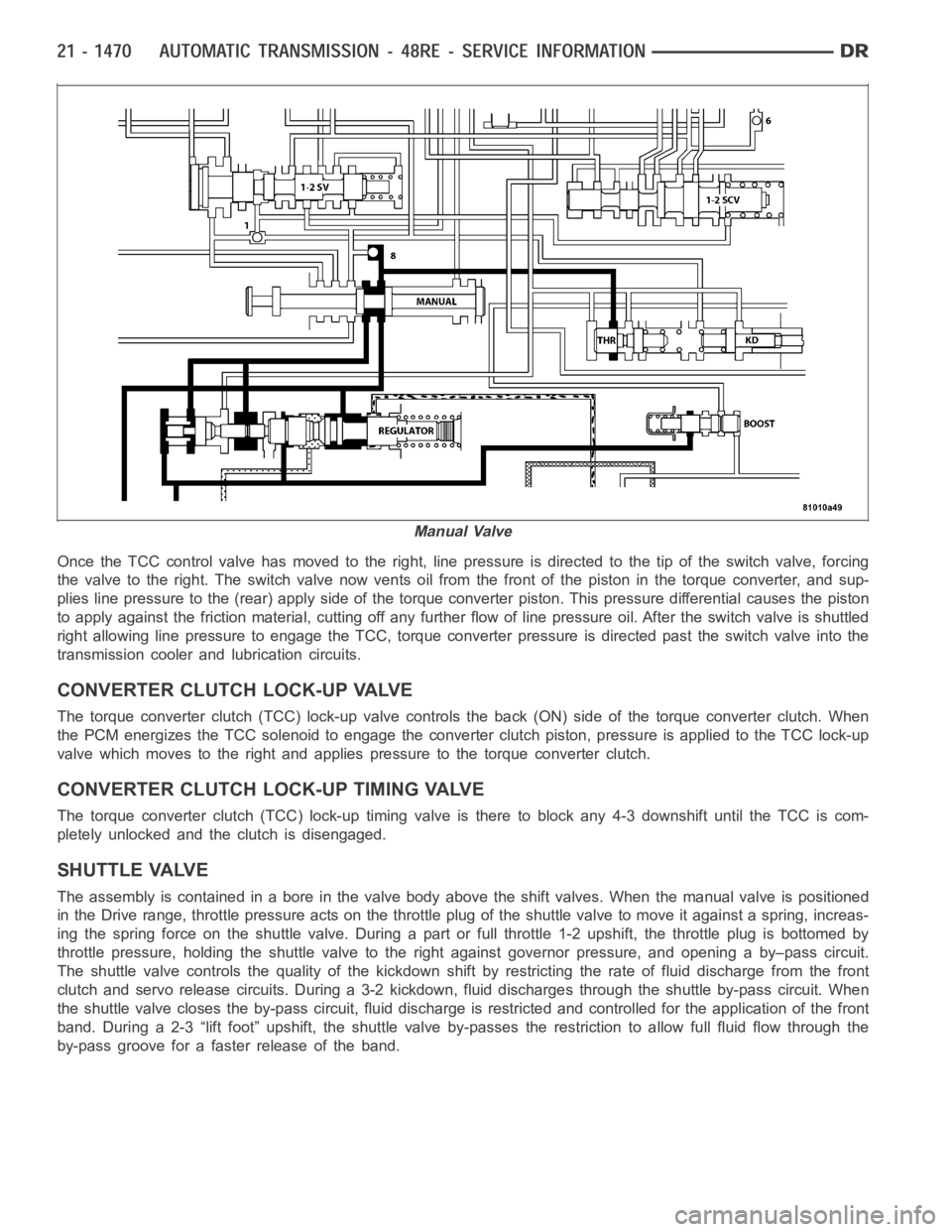
Once the TCC control valve has moved to the right, line pressure is directedto the tip of the switch valve, forcing
the valve to the right. The switch valve now vents oil from the front of the piston in the torque converter, and sup-
plies line pressure to the (rear) apply side of the torque converter piston. This pressure differential causes the piston
to apply against the friction material, cutting off any further flow of line pressure oil. After the switch valve is shuttled
right allowing line pressure to engage the TCC, torque converter pressureis directed past the switch valve into the
transmission cooler and lubrication circuits.
CONVERTER CLUTCH LOCK-UP VALVE
The torque converter clutch (TCC) lock-up valve controls the back (ON) side of the torque converter clutch. When
the PCM energizes the TCC solenoid to engage the converter clutch piston, pressure is applied to the TCC lock-up
valve which moves to the right and applies pressure to the torque converterclutch.
CONVERTER CLUTCH LOCK-UP TIMING VALVE
The torque converter clutch (TCC) lock-up timing valve is there to block any 4-3 downshift until the TCC is com-
pletely unlocked and the clutch is disengaged.
SHUTTLE VALVE
The assembly is contained in a bore in the valve body above the shift valves.When the manual valve is positioned
in the Drive range, throttle pressure acts on the throttle plug of the shuttle valve to move it against a spring, increas-
ing the spring force on the shuttle valve. During a part or full throttle 1-2upshift, the throttle plug is bottomed by
throttle pressure, holding the shuttle valve to the right against governor pressure, and opening a by–pass circuit.
The shuttle valve controls the quality of the kickdown shift by restricting the rate of fluid discharge from the front
clutch and servo release circuits. During a 3-2 kickdown, fluid discharges through the shuttle by-pass circuit. When
the shuttle valve closes the by-pass circuit, fluid discharge is restricted and controlled for the application of the front
band. During a 2-3 “lift foot” upshift, the shuttle valve by-passes the restriction to allow full fluid flow through the
by-pass groove for a faster release of the band.
Manual Valve
Page 3992 of 5267
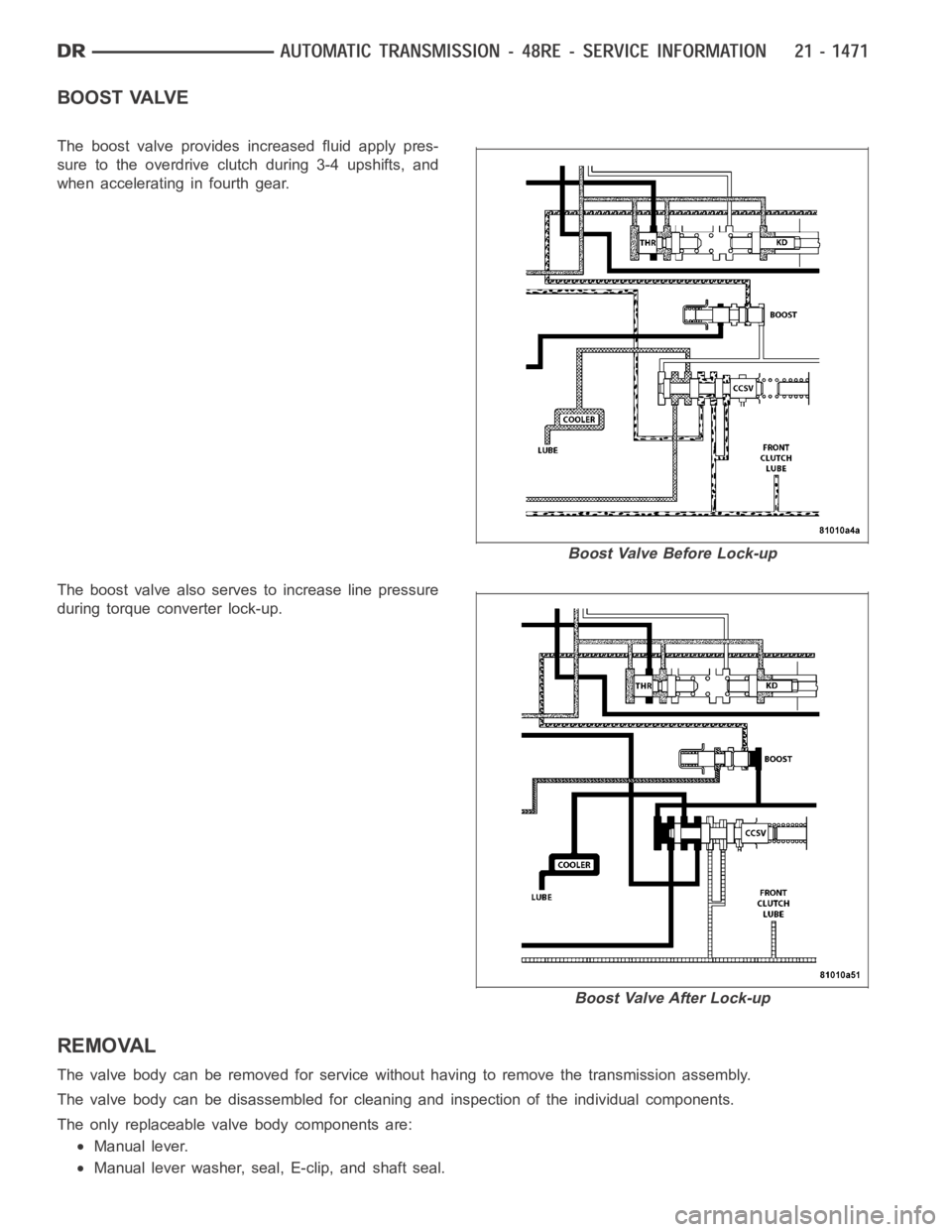
BOOST VALVE
The boost valve provides increased fluid apply pres-
sure to the overdrive clutch during 3-4 upshifts, and
when accelerating in fourth gear.
Theboostvalvealsoservestoincreaselinepressure
during torque converter lock-up.
REMOVAL
The valve body can be removed for service without having to remove the transmission assembly.
The valve body can be disassembled for cleaning and inspection of the individual components.
The only replaceable valve body components are:
Manual lever.
Manual lever washer, seal, E-clip, and shaft seal.
Boost Valve Before Lock-up
Boost Valve After Lock-up
Page 3993 of 5267
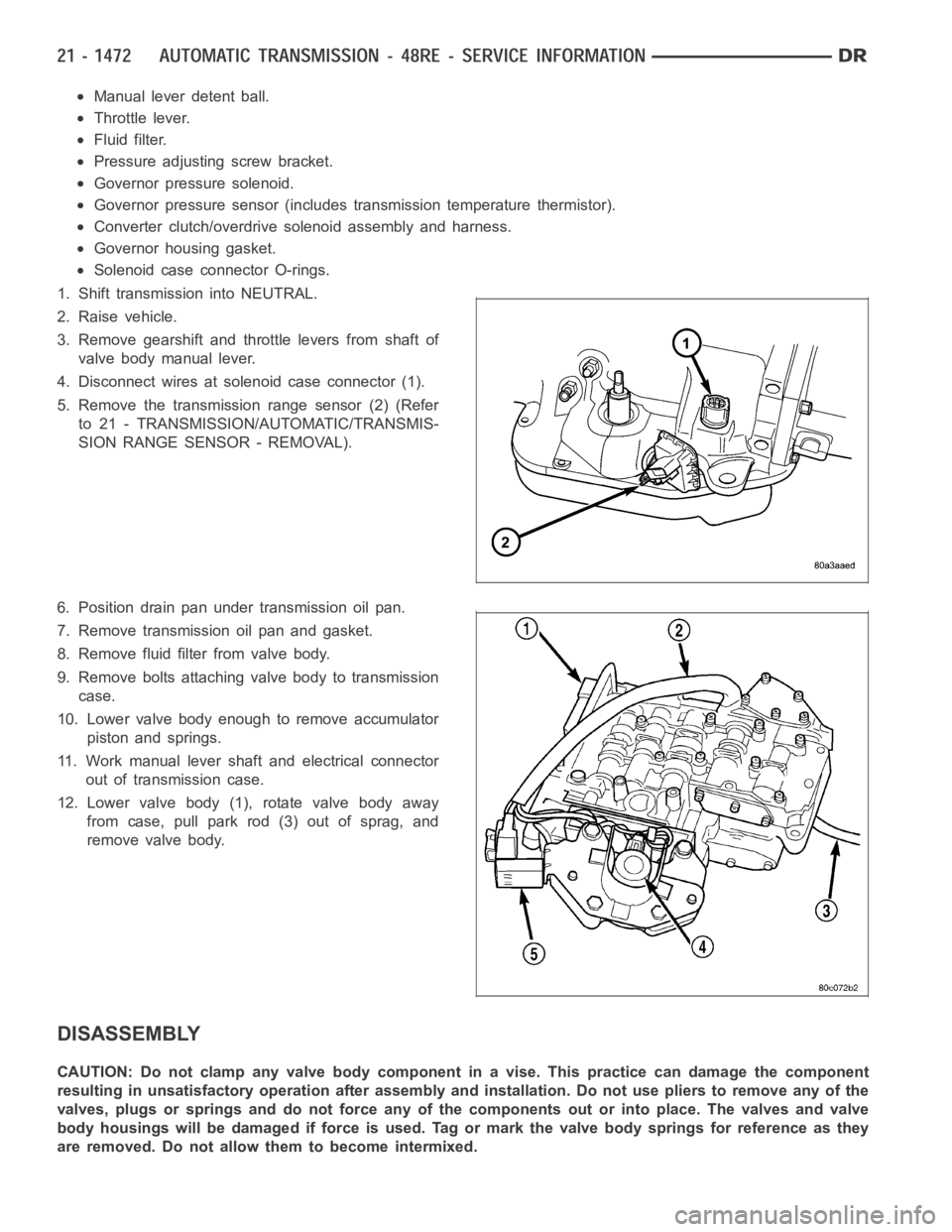
Manual lever detent ball.
Throttle lever.
Fluid filter.
Pressure adjusting screw bracket.
Governor pressure solenoid.
Governor pressure sensor (includes transmission temperature thermistor).
Converter clutch/overdrive solenoid assembly and harness.
Governor housing gasket.
Solenoid case connector O-rings.
1. Shift transmission into NEUTRAL.
2. Raise vehicle.
3. Remove gearshift and throttle levers from shaft of
valve body manual lever.
4. Disconnect wires at solenoid case connector (1).
5. Remove the transmission range sensor (2) (Refer
to 21 - TRANSMISSION/AUTOMATIC/TRANSMIS-
SION RANGE SENSOR - REMOVAL).
6. Position drain pan under transmission oil pan.
7. Remove transmission oil pan and gasket.
8. Remove fluid filter from valve body.
9. Remove bolts attaching valve body to transmission
case.
10. Lower valve body enough to remove accumulator
piston and springs.
11. Work manual lever shaft and electrical connector
out of transmission case.
12. Lower valve body (1), rotate valve body away
from case, pull park rod (3) out of sprag, and
remove valve body.
DISASSEMBLY
CAUTION: Do not clamp any valve body component in a vise. This practice can damage the component
resulting in unsatisfactory operation after assembly and installation.Do not use pliers to remove any of the
valves, plugs or springs and do not force any of the components out or into place. The valves and valve
body housings will be damaged if force is used. Tag or mark the valve body springs for reference as they
are removed. Do not allow them to become intermixed.
Page 3994 of 5267

1. Disconnect wires from governor pressure sensor
and solenoid.
2. Remove screws attaching governor body and
retainer plate to transfer plate.
3. Remove retainer plate, governor body and gasket
from transfer plate.
4. Remove governor pressure sensor from governor
body.
5. Remove governor pressure solenoid by pulling it
straight out of bore in governor body. Remove and
discard solenoid O-rings if worn, cut, or torn.
6. Remove small shoulder bolt that secures solenoid
harness case connector (1) to 3-4 accumulator
housing (2). Retain shoulder bolt. Either tape it to
harness or thread it back into accumulator housing
after connector removal.
7. Unhook overdrive/converter solenoid harness (1)
from 3-4 accumulator cover plate (2)
.
8. Turn valve body over and remove screws that
attach overdrive/converter solenoid assembly (1) to
valve body.
Page 3995 of 5267
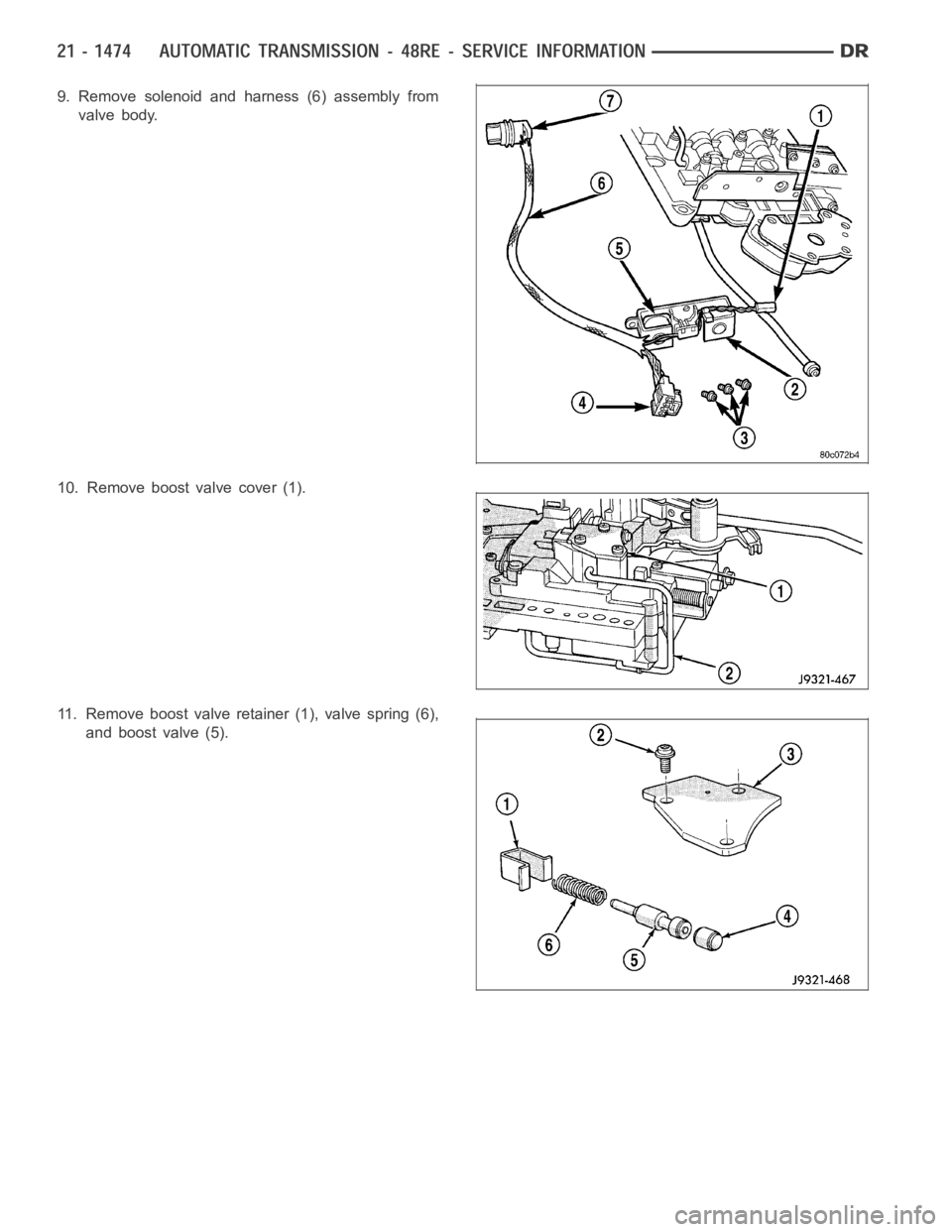
9. Remove solenoid and harness (6) assembly from
valve body.
10. Remove boost valve cover (1).
11. Remove boost valve retainer (1), valve spring (6),
and boost valve (5).
Page 3996 of 5267
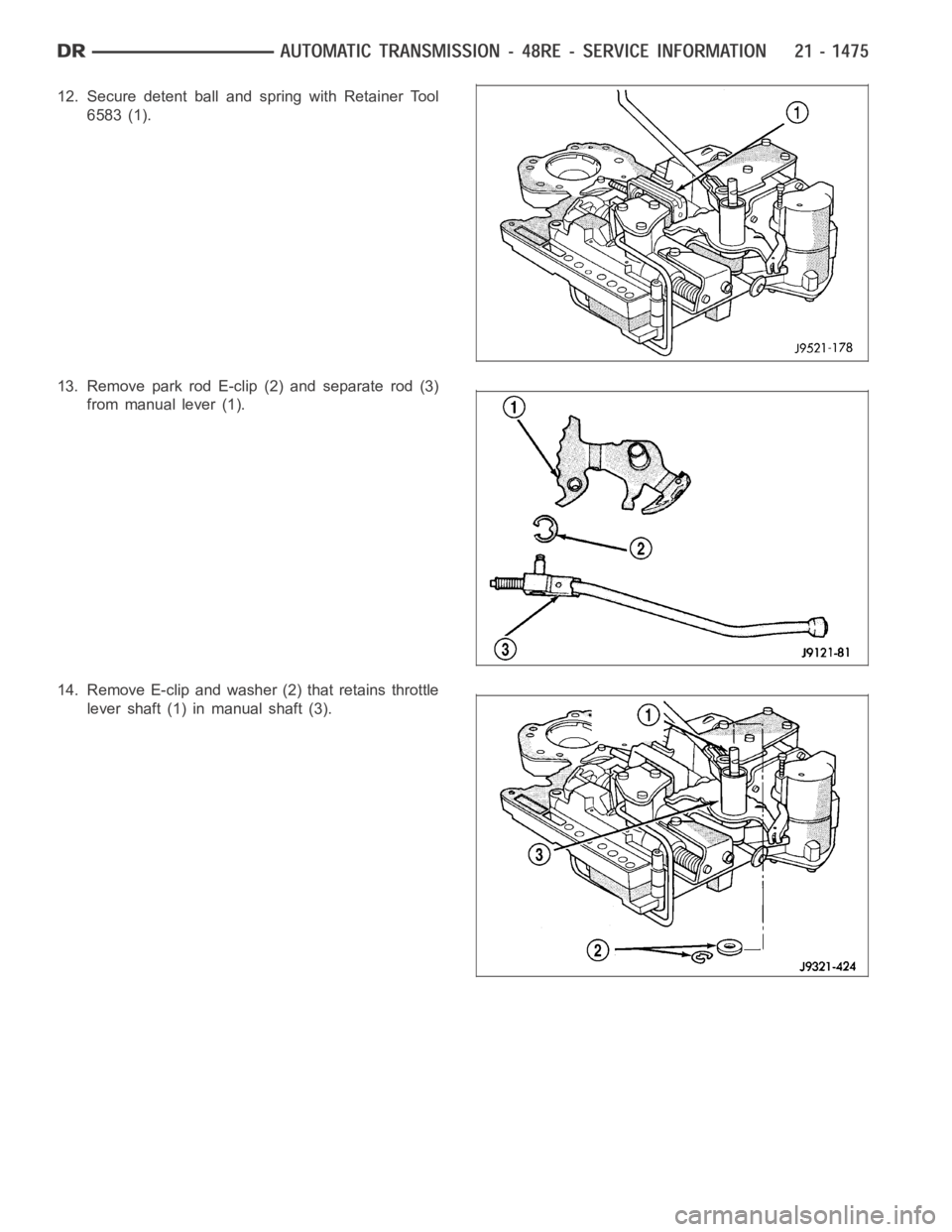
12. Secure detent ball and spring with Retainer Tool
6583 (1).
13. Remove park rod E-clip (2) and separate rod (3)
from manual lever (1).
14. Remove E-clip and washer (2) that retains throttle
lever shaft (1) in manual shaft (3).
Page 3997 of 5267
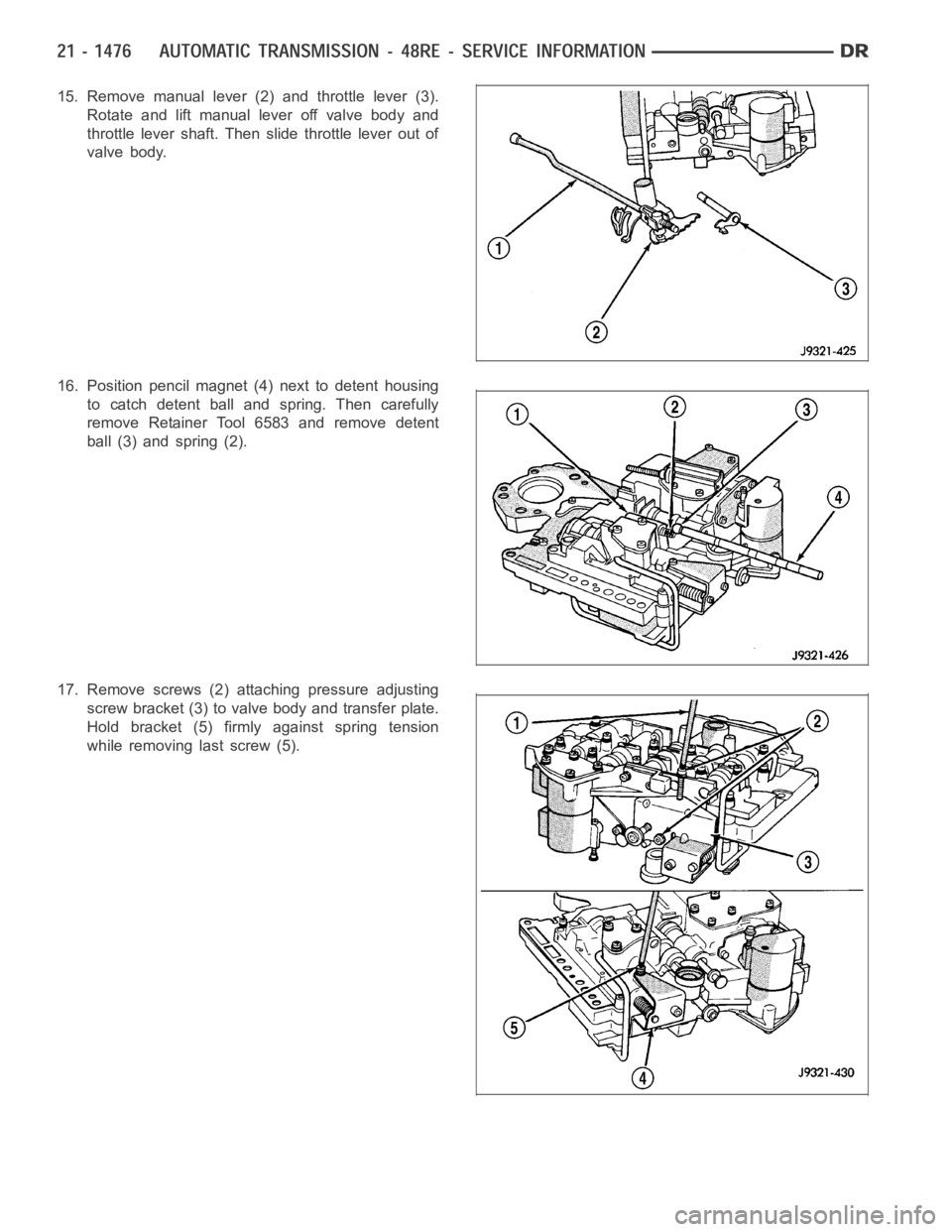
15. Remove manual lever (2) and throttle lever (3).
Rotate and lift manual lever off valve body and
throttle lever shaft. Then slide throttle lever out of
valve body.
16. Position pencil magnet (4) next to detent housing
to catch detent ball and spring. Then carefully
remove Retainer Tool 6583 and remove detent
ball (3) and spring (2).
17. Remove screws (2) attaching pressure adjusting
screw bracket (3) to valve body and transfer plate.
Hold bracket (5) firmly against spring tension
while removing last screw (5).
Page 3998 of 5267
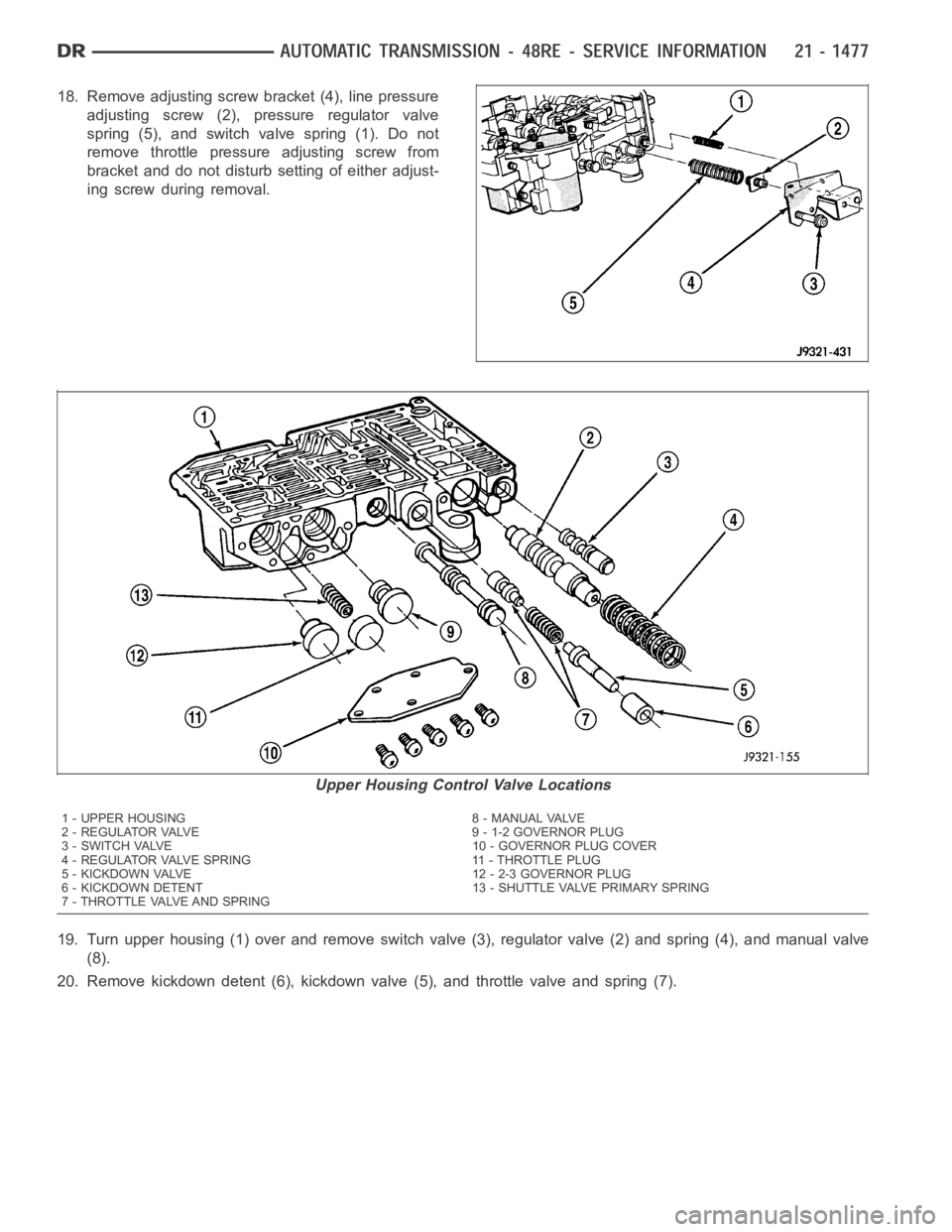
18. Remove adjusting screw bracket (4), line pressure
adjusting screw (2), pressure regulator valve
spring (5), and switch valve spring (1). Do not
remove throttle pressure adjusting screw from
bracket and do not disturb setting of either adjust-
ing screw during removal.
19. Turn upper housing (1) over and remove switch valve (3), regulator valve (2) and spring (4), and manual valve
(8).
20. Remove kickdown detent (6), kickdown valve (5), and throttle valve andspring (7).
Upper Housing Control Valve Locations
1 - UPPER HOUSING 8 - MANUAL VALVE
2 - REGULATOR VALVE 9 - 1-2 GOVERNOR PLUG
3 - SWITCH VALVE 10 - GOVERNOR PLUG COVER
4 - REGULATOR VALVE SPRING 11 - THROTTLE PLUG
5 - KICKDOWN VALVE 12 - 2-3 GOVERNOR PLUG
6 - KICKDOWN DETENT 13 - SHUTTLE VALVE PRIMARY SPRING
7 - THROTTLE VALVE AND SPRING
Page 3999 of 5267
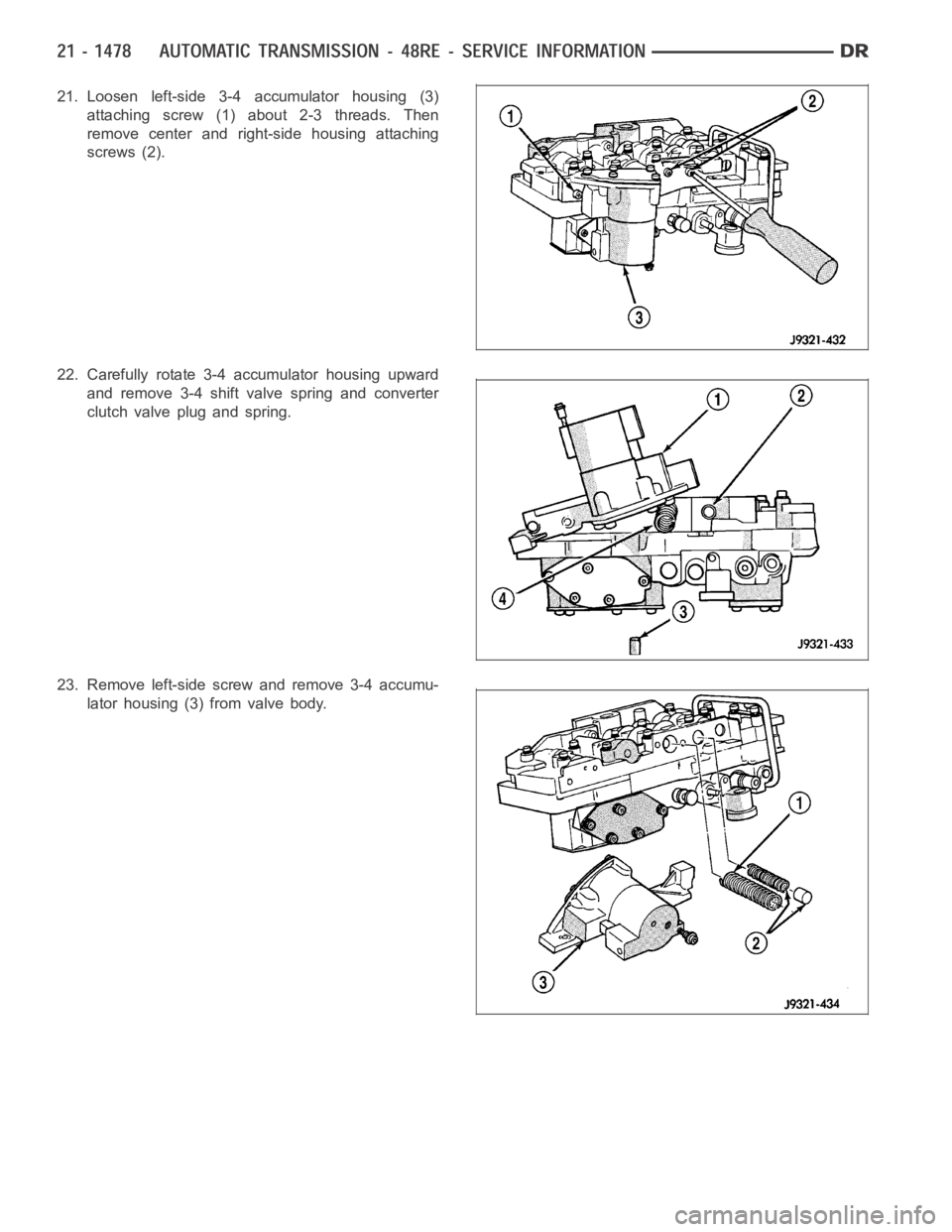
21. Loosen left-side 3-4 accumulator housing (3)
attaching screw (1) about 2-3 threads. Then
remove center and right-side housing attaching
screws (2).
22. Carefully rotate 3-4 accumulator housing upward
and remove 3-4 shift valve spring and converter
clutch valve plug and spring.
23. Remove left-side screw and remove 3-4 accumu-
lator housing (3) from valve body.
Page 4000 of 5267
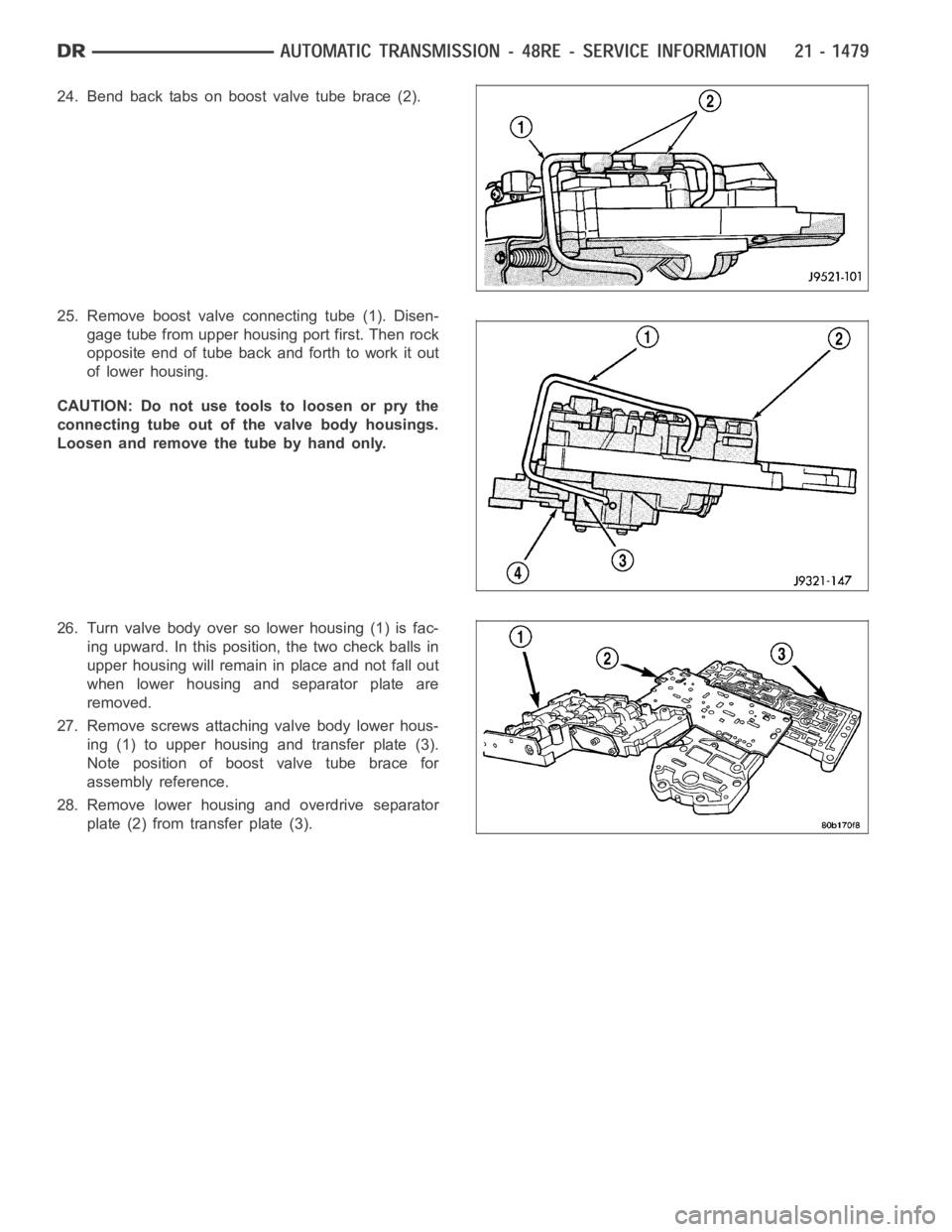
24. Bend back tabs on boost valve tube brace (2).
25. Remove boost valve connecting tube (1). Disen-
gage tube from upper housing port first. Then rock
opposite end of tube back and forth to work it out
of lower housing.
CAUTION: Do not use tools to loosen or pry the
connecting tube out of the valve body housings.
Loosen and remove the tube by hand only.
26. Turn valve body over so lower housing (1) is fac-
ing upward. In this position, the two check balls in
upper housing will remain in place and not fall out
when lower housing and separator plate are
removed.
27. Remove screws attaching valve body lower hous-
ing (1) to upper housing and transfer plate (3).
Note position of boost valve tube brace for
assembly reference.
28. Remove lower housing and overdrive separator
plate (2) from transfer plate (3).